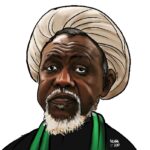In the aftermath of the 2015 bloody incident between El-Zakzaky’s Shiite followers and the Nigerian military in Zaria, Iran launched a worldwide campaign of incitement against the Nigerian government.
It deployed its sponsored London-based so-called Islamic Human Rights Commission (IHRC) and other groups for that purpose, while its apologists disguised as analysts vigorously promoted its propaganda against the Nigerian government.
- PODCAST: The Supplementary Budget: Who Benefits Most?
- Hushpuppi: US Court lists DCP Kyari among wanted suspects
In the absence of appropriate resources, expertise and influence on the part of the Nigerian government to counter the campaign, Iran succeeded in influencing the international media narrative not only about the incident but also about Zakzaky’s activities in Nigeria. Many otherwise discerning analysts and, of course, many unsuspecting observers fell for that influenced narrative and carried on churning out “analyses” accordingly for various international media organisations.
Shiite protests were equally organised in many countries to incite public opinion across the world against the Nigerian government. A two-part article of mine titled Mismanagement of Zakzaky’s detention” (Daily Trust, Friday, August 9, 2019), among other relevant articles in this column, addressed how Iran pursued that campaign.
Meanwhile, the Nigerian government was increasingly worried over the potentially damaging implications of the campaign on its already poorly managed image. Also, there were worries and warnings left, right, and centre that the aftermath of the incident could trigger another terror insurgency while the government was already struggling with the Boko Haram terror group.
From a report by the News Agency of Nigeria (NAN) in 2019, it’s obvious that the Nigerian government reached out to Iran in pursuit of some understanding with it on the crisis. Because as the report rightly maintains, Zakzaky’s “IMN is seen as the benefactor and vehicle for the import of Iranian Shia ideology in Nigeria and West African sub-region”.
According to the report also, there was a series of “secret engagements, discreet contacts and cultivations” between government officials from both countries. It’s also quite clear from the report that the Nigerian government demanded that Iran abandon the violent Zakzaky-led Shiite faction in Nigeria, IMN and instead adopt RAAF, which it (Nigeria government) considers nonviolent. The report equally suggests that the Nigerian government capitalised its argument on the fact that Zakzaky didn’t actually earn his turban as he isn’t actually a Shiite scholar in the real sense having never learned the creed through appropriate channels; whereas, RAAF’s leader, Nur Dass, is believed to have earned his turban through learning before he became a turbaned Shiite cleric.
Interestingly, RAAF and indeed other Shiite factions in Nigeria are equally loyal to Iran and enjoy its patronage albeit not as much as Zakzaky’s faction. RAAF’s purported nonviolence is sanctioned by Iran for tactical reasons. As a strategy to ensure the consistent loyalty of its Shiite proxies wherever it operates, Iran keeps as many proxies as possible in one country where they struggle to outdo one another in proving their loyalty to it.
Anyway, though the report, or rather the part thereof revealed by the NAN, didn’t touch on Iran’s demands, it can be reasonably deduced that it had demanded the release of Zakzaky in return, as implied by the subsequent developments. For instance, while since then Iran has steadily scaled down its campaign against the Nigerian government, the Nigerian authorities, in turn, began to handle Zakzaky’s case in a way clearly intended to culminate in his eventual acquittal through seemingly regular but actually manipulated judicial processes.
Zakzaky’s acquittal, therefore, wasn’t actually on judicial bases, after all. Besides, regardless of whether or not he was responsible for the 2015 incident, nobody can rightly deny his more than thirty years of blatant defiance of the constituted authorities, subversive activities against the Nigerian state, and harassment of the general public.
It’s also clear that the Nigerian government naively fell for Iran’s commitment to withdrawing its support to Zakzaky as the report suggests. Whereas, Iran would never abandon Zakzaky having invested in his rise for more than three decades in the course of which he has been able to nurture the Shiite population in Nigeria, which is the largest of its kind in Sub Saharan Africa; and which also maintains absolute loyalty to the theocratic regime in Tehran. Iran cherishes the Shiite population in Nigeria as a strategic advantage in its more than four-decade-old agenda to dominate Muslim countries and communities across the world under its Wilayatul-Faqeeh theocratic ideology.
As things stand, it’s just a matter of time before the Nigerian government realises that it has been utterly naïve if not irresponsible in its handling of Zakzaky’s case that way.
For now, he would most likely proceed on rehabilitation retreat probably in Iran to come back and resume his subversive activities. At that point, his unsuspecting sympathisers who innocently fell for the propaganda of his purported innocence would definitely end up disappointed, while the hypocrisy of his apologists who have deliberately promoted the propaganda just to spite their real or perceived religious, political, philosophical or sectarian opponents, would be further exposed.
Meanwhile, while it isn’t clear where he will live, Gyallesu residents, its environs and indeed Zaria at large are definitely worried over the looming possibility of the return of the era of constant harassment, bullying and intimidation, which his militia, Hurras, had perpetrated against them for decades on the pretext of guarding him.

 Join Daily Trust WhatsApp Community For Quick Access To News and Happenings Around You.
Join Daily Trust WhatsApp Community For Quick Access To News and Happenings Around You.